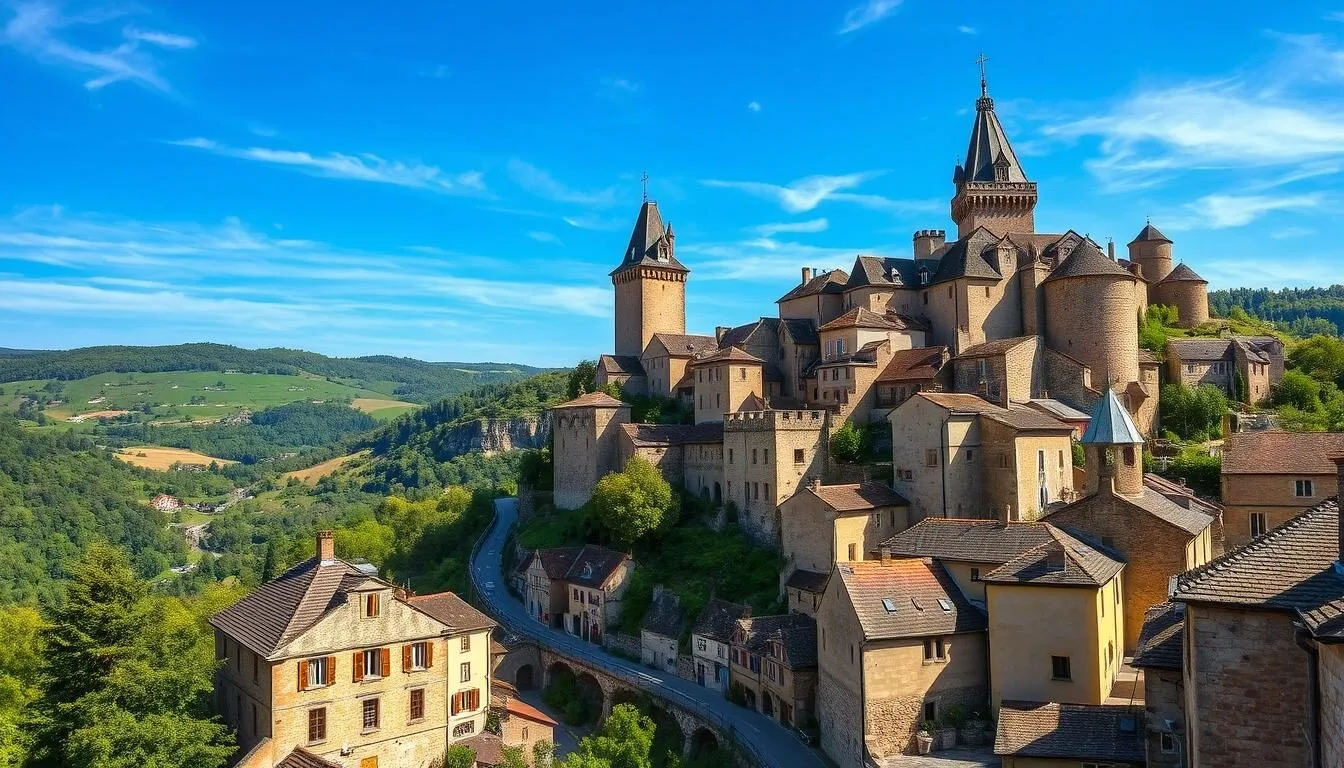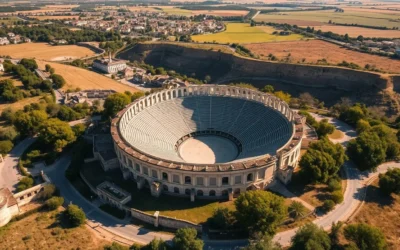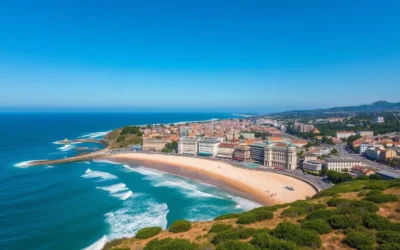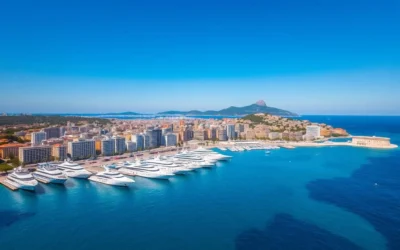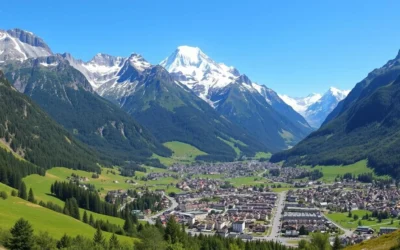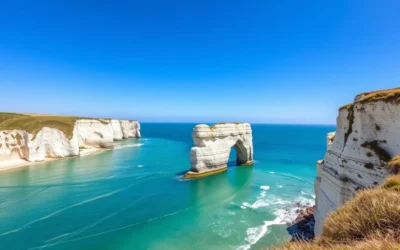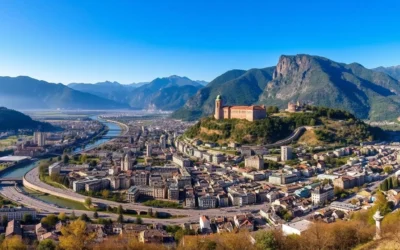✓ Accommodations✓ Flights✓ Rental Cars
Imagine standing at the edge of a cliff, gazing out at a medieval village perched precariously on the side of a limestone gorge. Welcome to Rocamadour, a place where history and natural beauty converge. As you wander through the narrow alleys, you’ll discover a world where spirituality and adventure blend seamlessly.
This UNESCO World Heritage site has been a significant pilgrimage destination since the 12th century, attracting visitors from around the world. As you visit Rocamadour, you’ll uncover the secrets of its sacred sanctuary complex, explore the medieval village, and take in the breathtaking panoramic views. With its rich history and unique landscape, Rocamadour promises an unforgettable experience.
Are you ready to explore one of “The Most Beautiful Villages in France”? Let’s dive into the top things to do in this incredible destination.
Discovering the Medieval Marvel of Rocamadour
Perched on a steep limestone cliff, the village of Rocamadour is a breathtaking example of medieval engineering. As you explore this ancient village, you’ll discover a world where architecture and nature blend seamlessly together. The village’s unique setting, with its buildings clinging to the cliff face, is a marvel that has captivated visitors for centuries.
The village of Rocamadour is tiny, yet it is packed with history and architectural wonders. Its three-tiered layout is a testament to the ingenuity of medieval builders. At the bottom lies the village itself, with its charming streets and historic buildings. In the middle, you’ll find the sanctuary complex, a significant religious site. Finally, crowning the cliff is the castle, a formidable structure that adds to the village’s dramatic landscape.
The Gravity-Defying Village on the Cliff
Rocamadour’s architecture is characterized by its ability to defy gravity, with buildings seemingly stuck to the cliff face. This gravity-defying appearance is not just visually striking; it’s also a testament to the advanced engineering skills of the medieval builders who constructed this village over 900 years ago.
- Marvel at the way the village’s buildings cling to the steep limestone cliff, creating a dramatic and unforgettable landscape.
- Understand the unique layout of Rocamadour, with its village, sanctuary complex, and castle forming a cohesive and impressive whole.
- Appreciate the engineering feat that Rocamadour represents, with its structures blending into the natural landscape.
- Discover the geological features that made Rocamadour an ideal location for a medieval settlement, which would eventually become one of France’s most important religious sites.
The village’s layout and architecture are deeply intertwined with its natural surroundings. Locals describe it poetically as “houses on the river, churches on the houses, rocks on the churches, castle on the rock,” highlighting the seamless integration of human construction and natural landscape.
As you explore Rocamadour, you’ll be struck by its beauty and historical significance. The village offers a unique glimpse into medieval life, with its narrow streets, historic buildings, and stunning cliffside setting. Whether you’re interested in history, architecture, or simply experiencing the beauty of this unique site, Rocamadour is a destination that promises to leave a lasting impression.
The Gravity-Defying Village on the Cliff
Perched precariously on a cliff, Rocamadour is a village that defies gravity and beckons history enthusiasts and pilgrims alike. This medieval village has a rich history that spans centuries, making it a fascinating place to explore.
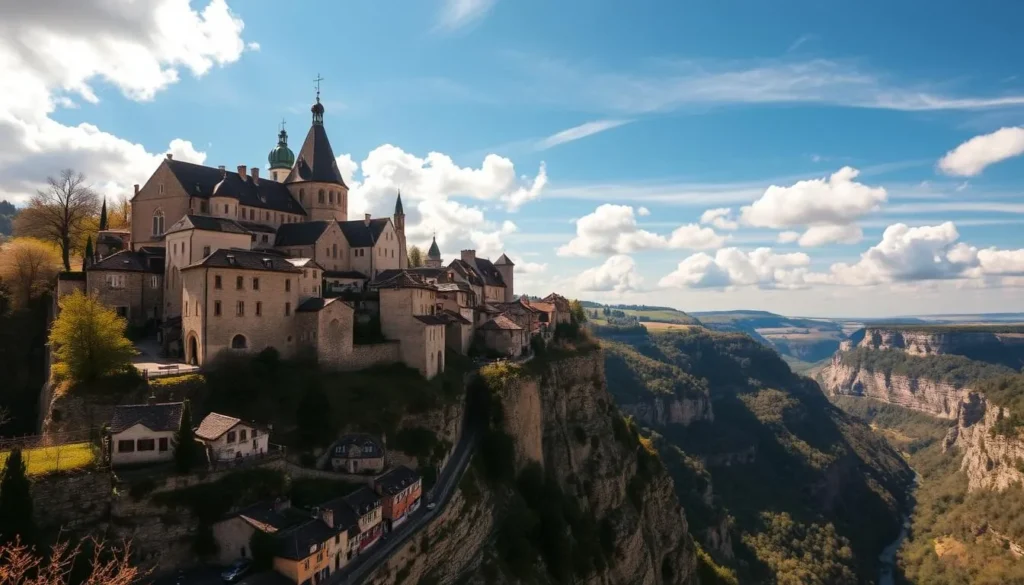
A Sacred Site Through the Ages
Rocamadour’s significance is deeply rooted in its history and the legends surrounding it. According to legend, the village is named after Saint Amadour, whose perfectly preserved body was discovered in the Sanctuary of the Black Madonna in 1166. This event catapulted Rocamadour to fame, making it one of the four most important Christian pilgrimage sites alongside Jerusalem, Rome, and Santiago de Compostela by the 12th century.
Over centuries, Rocamadour has experienced periods of great prosperity and decline. During its golden age in the 13th century, kings and nobility from across Europe made pilgrimages to this sacred site. However, the village faced significant challenges, including a devastating rock slide in the 15th century that destroyed the Notre Dame Church, the desecration of St. Amadour’s body by Huguenots in 1562, and the devastation during the French Revolution.
- Explore the fascinating origins of Rocamadour and its connection to Saint Amadour.
- Learn about Rocamadour’s rise to prominence in the 12th century as a major Christian pilgrimage destination.
- Discover the village’s golden age during the 13th century and its significance in European history.
- Understand the challenges Rocamadour faced over the time, including natural disasters and religious conflicts.
- Appreciate the efforts made to restore Rocamadour to its former glory, making it a significant place for both spiritual reflection and tourism.
Today, visitors can walk through the village’s narrow streets, taking in the historical atmosphere and visiting the various chapels and sanctuaries that dot the landscape. Rocamadour’s unique blend of history, spirituality, and natural beauty makes it a compelling destination for anyone interested in exploring the depths of France’s cultural heritage.
Why Rocamadour Should Be on Your French Itinerary
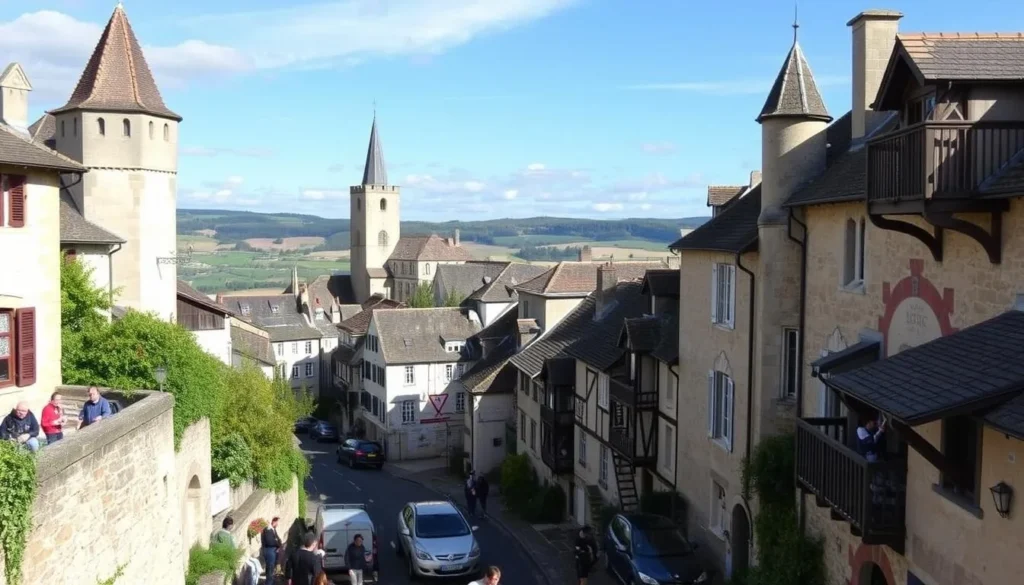
As part of the prestigious St. James’ Way pilgrimage route, Rocamadour has been a significant cultural and spiritual hub for centuries. This medieval village is not just a place to visit; it’s an experience that combines history, architecture, and natural beauty.
UNESCO World Heritage Status
Rocamadour is one of the over 150 villages recognized as ‘Plus Beaux Villages de France’ (or Prettiest Villages in France). Its inclusion as a UNESCO World Heritage site is a testament to its cultural and historical significance as part of the St. James’ Way pilgrimage route.
- Understand why Rocamadour’s UNESCO World Heritage status makes it a must-visit destination on any French itinerary.
- Learn about Rocamadour’s significance as part of the St. James’ Way pilgrimage route, which has been recognized for its cultural and historical importance.
- Discover how Rocamadour’s designation as one of “The Most Beautiful Villages in France” sets it apart from thousands of other French villages.
- Appreciate the cultural significance of visiting a place that has attracted pilgrims and travelers for over eight centuries.
- Understand how Rocamadour serves as an excellent base for exploring the broader Occitanie region, with its castles, caves, and other medieval villages.
- Recognize the unique experience of visiting a place where religious history, architectural marvels, and natural beauty converge in one unforgettable location for visitors.
With its rich history and stunning surroundings, Rocamadour is not only worth visiting but also makes for an ideal base to explore the rest of the Occitanie region.
One of “The Most Beautiful Villages in France”

As you step into the medieval village of Rocamadour, you’ll be transported to a bygone era. The tiny village starts at the Porte du Figuier (Fig Tree Gate) and ends at the Porte Basse (Lower Gate), with half-timbered houses lining the one-kilometer stretch of the main road.
Exploring the Medieval Village
The village is essentially just one long street, with the central axis bearing two names: Rue Roland le Preux for the first half and Rue de la Couronnerie after Porte Salmon (Salmon Gate). You can stroll along the charming main street, admiring the beautiful half-timbered medieval houses that offer a glimpse into life centuries ago.
- Stroll along the charming main street of Rocamadour, which stretches just one kilometer from the Porte du Figuier (Fig Tree Gate) to the Porte Basse (Lower Gate).
- Admire the beautiful half-timbered medieval houses that line the pedestrian-only street, offering a glimpse into life centuries ago.
- Discover the central axis of the village which changes names halfway through – starting as Rue Roland le Preux and becoming Rue de la Couronnerie after passing through the picturesque Porte Salmon (Salmon Gate).
- Experience the authentic medieval atmosphere that has earned Rocamadour its place among “The Most Beautiful Villages in France.”
- Learn about the daily life in this tiny village that has just 600 permanent residents but welcomes over 1.5 million visitors annually.
- Appreciate the best times to explore the village – early morning or evening when the day tourists have departed and you can have the medieval streets almost to yourself.
With its rich history, stunning architecture, and picturesque streets, Rocamadour is a must-visit destination for anyone interested in exploring the best of France’s medieval heritage.
Strolling Along Rue Roland le Preux
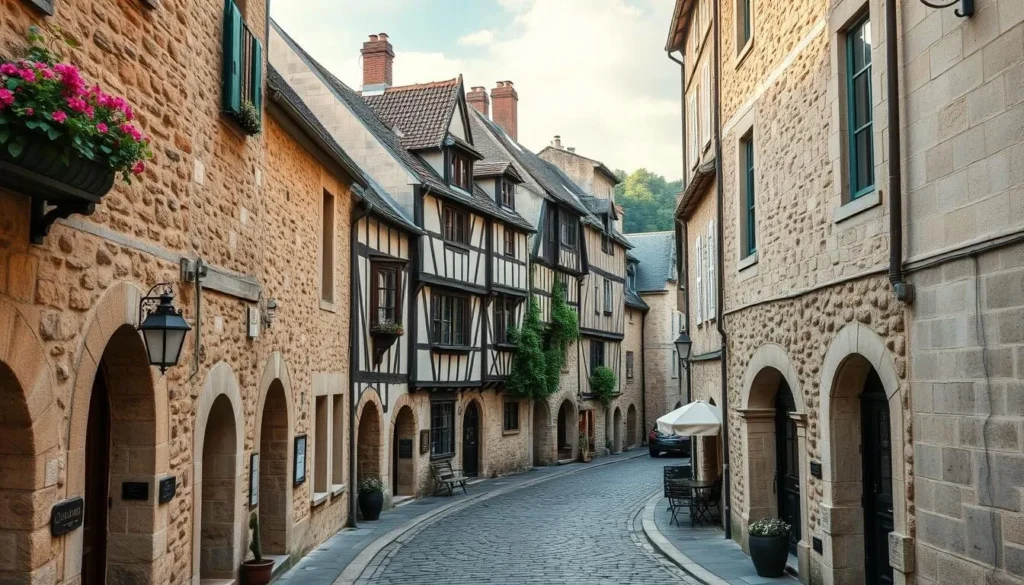
Strolling along Rue Roland le Preux, you’ll discover the essence of Rocamadour’s medieval charm. This main thoroughfare is lined with beautifully preserved half-timbered houses, many of which date back several centuries.
The Charming Gates and Half-Timbered Houses
As you wander along this pedestrian-only street, you’ll come across three historic gates: Porte du Figuier (Fig Tree Gate), Porte Salmon (Salmon Gate), and Porte Basse (Lower Gate). Each gate has its own unique architectural character, adding to the village’s historical allure.
The sanctuary complex towers above you as you stroll through the village streets, with the chateau resting on top of the cliff – a truly stunning view. The village is filled with a variety of artisan shops, cafés, and restaurants that now occupy these historic buildings, offering local specialties and crafts.
- Wander along Rue Roland le Preux and discover its charming atmosphere.
- Admire the beautifully preserved half-timbered houses that line the street.
- Explore the three historic gates along your walk.
- Experience the unique perspective of having the sanctuary complex towering above you.
- Visit the various artisan shops, cafés, and restaurants that offer local specialties and crafts.
- Consider timing your visit for early morning or evening when the village is quieter.
Timing your visit to the village during the early morning or evening can make a significant difference, allowing you to appreciate the medieval architecture without the crowds. Whether you’re looking to explore the town, visit the local eateries, or simply enjoy the way the light falls on the village, Rue Roland le Preux is a must-visit destination.
The Sanctuary of Rocamadour: A Spiritual Journey
The Grand Staircase of Rocamadour’s sanctuary is more than just a path; it’s a way to connect with the pilgrims who have walked this route for centuries.
The Grand Staircase (L’Escalier des Pèlerins)
As you visit the Sanctuary, you’ll encounter the impressive Grand Staircase, a monumental stairs structure that has been a part of the pilgrimage for centuries. This 216-step staircase is not just a means to reach the sanctuary; it’s an integral part of the spiritual experience.
The staircase is divided into sections with landings and courtyards, making the ascent manageable and allowing pilgrims to pause and reflect. Historically, pilgrims would climb these stairs on their knees as an act of devotion, a testament to their faith.
As you make your way up, you’ll be treated to spectacular views of the village and valley below. The Grand Staircase leads you through the impressive Porte Saint and into the main square of the sanctuary, marking the culmination of your spiritual journey.
- Climb the famous Grand Staircase, the traditional route for pilgrims consisting of 216 steps connecting the village to the sanctuary.
- Understand the religious significance of these stairs and appreciate how they’re divided into sections for a more manageable ascent.
- Pass through Porte Saint at the top, the main entrance to the sanctuary complex.
- Enjoy the views of the village and valley as you ascend this historic stairway.
- Note that while climbing offers the most authentic experience, an elevator is available for those with mobility concerns.
Notre Dame Chapel and the Black Madonna
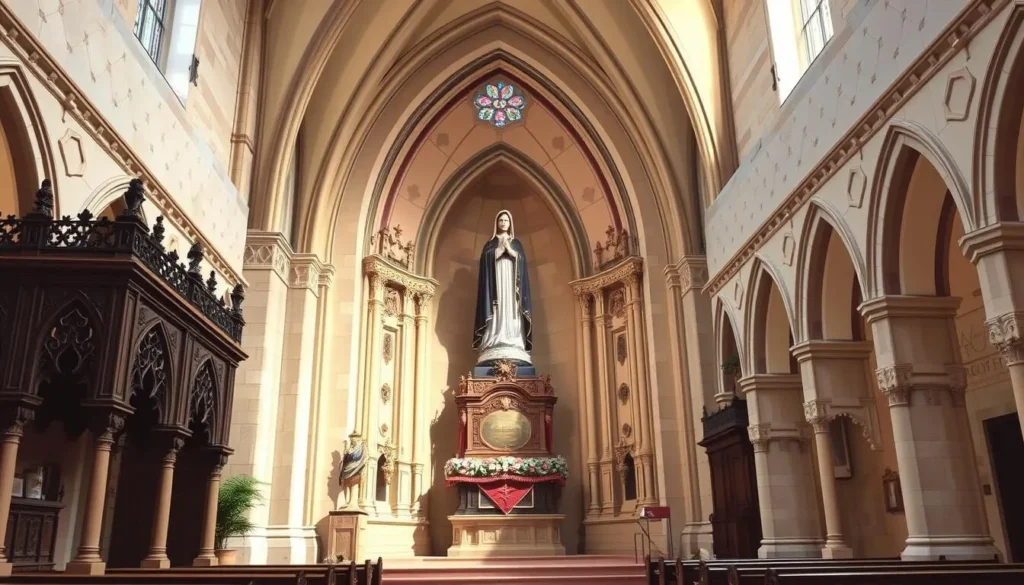
The spiritual heart of Rocamadour lies in the Chapelle Notre Dame, a sacred site revered for centuries. This chapel is home to the revered Black Madonna, a 12th-century statue known as the Vierge Noire.
The Chapelle Notre Dame de Rocamadour is famous not only for its stunning architecture but also for the legend surrounding its bell, which is said to ring on its own when a miracle is about to occur. This phenomenon has contributed to the chapel’s mystique, attracting visitors and pilgrims from around the world.
The Seven Sacred Chapels
The Sanctuary of Rocamadour is a complex of seven sacred chapels, each with its own unique history and architectural features. Visitors can explore the Chapelle Saint-Michel, known for its 12th-century frescoes, as well as the Chapelle Saint-Blaise, Chapelle Saint-Jean, and Chapelle Sainte-Anne, among others.
As you wander through the sanctuary, you will discover a wealth of religious art and artifacts, including the tomb of Saint Amadour, whose discovery in 1166 established Rocamadour as a major pilgrimage site. You can also see the Durandal sword, said to have belonged to Roland, one of Charlemagne’s warriors.
The chapels are not only significant for their religious importance but also for their historical and cultural value. Visitors can obtain detailed information about each chapel from the tourism office or read up on them online, enhancing their understanding and appreciation of this sacred site.
Whether you are drawn to Rocamadour for its spiritual significance or its historical importance, the Chapelle Notre Dame and the surrounding chapels offer a profound and enriching experience. As you explore this complex, you become part of a centuries-old tradition of pilgrimage and discovery.
Climbing to Rocamadour Castle
The journey to Rocamadour Castle begins with the Chemin de la Croix, a scenic path with deep spiritual significance. This ancient route is not just a walk to the castle; it’s an experience that combines faith, history, and breathtaking views.
The Spiritual Significance of Chemin de la Croix
As you embark on the Chemin de la Croix, you’ll be following a path that has been traveled by pilgrims for centuries. The route is lined with 14 shrines, each representing a station of the cross and depicting scenes from the Passion of Christ. This way to the top of the hill is as much about spiritual reflection as it is about reaching the castle.
The path steadily climbs through a forest, offering exceptional viewpoints over the Alzou Valley. Even those who are not religious will appreciate the beauty and tranquility of this walk. Along the route, you’ll pass by the Saint-Sépulcre caves, former quarries that now serve as small places of worship.
| Feature | Description |
|---|---|
| Path Length | Approximately 1 km |
| Number of Shrines | 14 |
| Notable Landmarks | Saint-Sépulcre caves, Cross of Jerusalem |
At the end of the Chemin de la Croix, you’ll reach the Cross of Jerusalem, a symbol of the pilgrimage that brings visitors to this sacred site. The journey culminates at Rocamadour Castle, perched atop the hill, offering panoramic views of the surrounding landscape.
Panoramic Views from the Ramparts
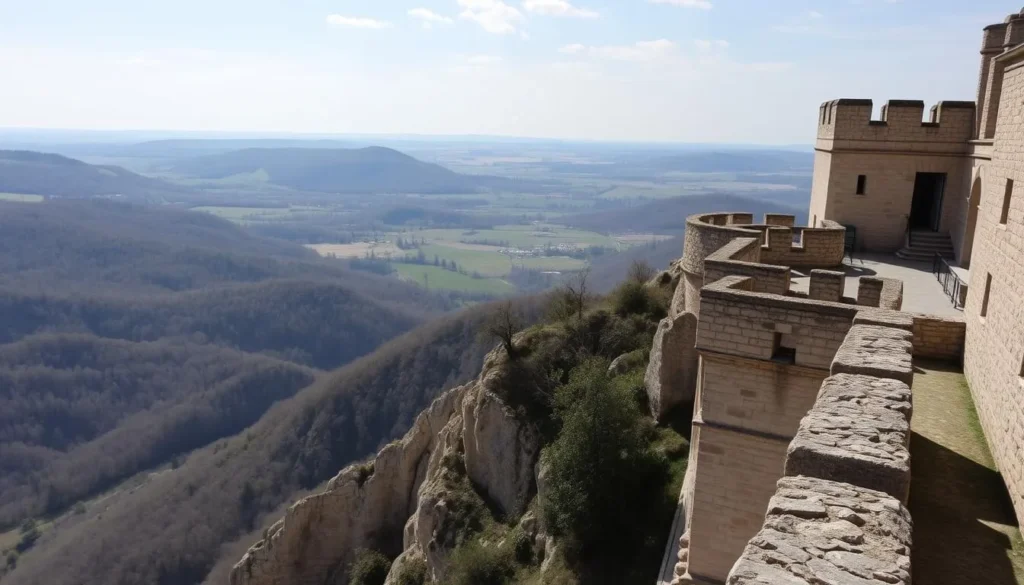
As you stand on the ramparts of Rocamadour Castle, the stunning views of the village and valley unfold before your eyes. The castle, perched dramatically at the top of a cliff, was built in the Middle Ages for defensive purposes and later restored in the 19th century.
Capturing the Beauty of Rocamadour
The ramparts, accessible for a mere €2 (cash only), offer breathtaking views over the entire village of Rocamadour and the Alzou Valley beyond. While the castle itself is not open to the public, the ramparts provide a unique perspective on the village’s layout and its surroundings.
Key highlights of visiting the ramparts include:
- Exploring the medieval castle ramparts at the very top of the cliff and enjoying panoramic views over the village and valley.
- Discovering the history of Rocamadour Castle, built to defend the sanctuary below.
- Experiencing the vertigo-inducing viewing platform that offers jaw-dropping views straight down onto the village.
- Learning about the strategic importance of the castle’s position.
- Appreciating the architectural features of the castle’s exterior and remaining defensive structures.
Standing on the ramparts, you’re treated to a unique perspective on the village’s medieval architecture and the natural beauty of the surrounding valley. It’s an experience that combines history, architecture, and natural beauty, making it a must-visit when in Rocamadour.
L’Hospitalet Viewpoint at Sunset
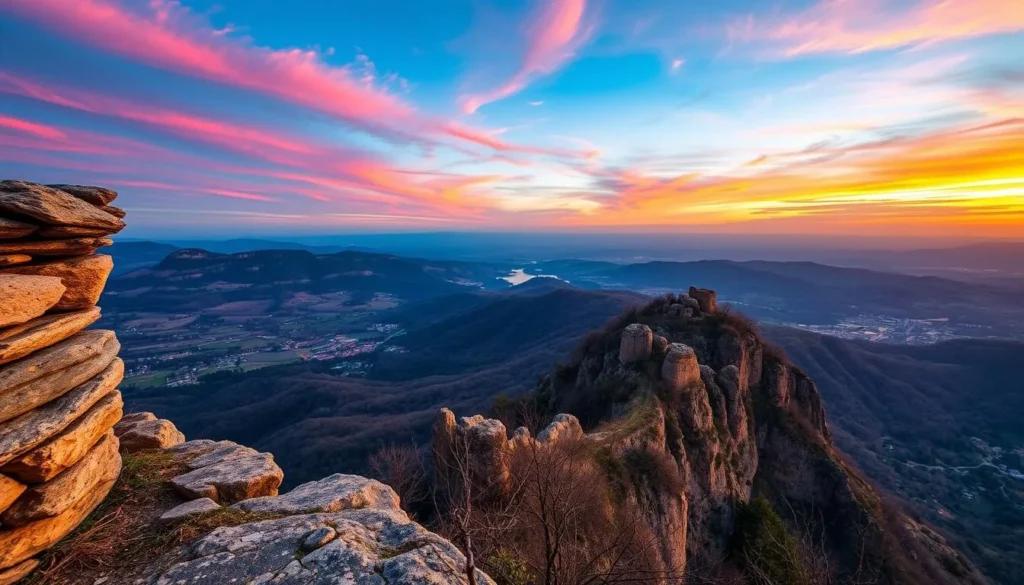
For an unforgettable view of Rocamadour, head to L’Hospitalet Viewpoint at sunset. The tiny village of L’Hospitalet, founded in the 11th century as a hospital for pilgrims traveling to and from Santiago de Compostela, offers some of the most spectacular views of Rocamadour.
Located on the opposite side of the Alzou Valley, L’Hospitalet provides an ideal location to appreciate the medieval village’s architecture and natural surroundings. During your stay, consider parking your car here, as it offers better value accommodations and easier parking compared to Rocamadour.
The Photographer’s Paradise
There are several excellent viewpoints to capture Rocamadour’s breathtaking beauty. One of the most popular spots is the little parking area of Hotel Bellevue, where you can find two stone benches offering an undisturbed view over the Alzou Valley and Rocamadour in the distance.
Another fantastic option is the terrace next to the Belvedere Restaurant, just a 2-minute walk from the Hospitalet Chapel. This spot provides a straight-on view that is particularly stunning. For a more dramatic perspective, visit Le Coin du Photographe platform, which offers an epic side viewpoint of Rocamadour clinging to the cliff.
To make the most of your visit, consider staying in L’Hospitalet. Not only does it offer better value accommodations, but it also provides immediate access to these stunning viewpoints. As you watch the sunset, the golden light illuminates the medieval buildings against the cliff, creating a truly magical atmosphere.
Whether you’re a photographer or simply someone who appreciates natural beauty, L’Hospitalet is a must-visit location to experience the best of Rocamadour. The village of L’Hospitalet, with its rich history and picturesque surroundings, is an integral part of the Rocamadour experience.
Unique Experiences in Rocamadour
For a truly unforgettable experience in Rocamadour, consider taking to the skies in a hot air balloon. This unique adventure offers a fresh perspective on the medieval village and its surroundings.
Soaring Above the Medieval Village
From Easter to All Saints’ Day (the first weekend of November), you have the opportunity to explore Rocamadour from above, suspended in a basket beneath a large hot air balloon. This experience, while not inexpensive, provides a memorable way to see the village. A 45-minute flight costs around €200 per person.
Two local companies, Rocamadour Montgolfières and Dordognes Montgolfières, offer hot air balloon rides. It’s worth noting that the weather can be a deciding factor; flights are weather-dependent, and conditions must be suitable for the ride to take place.
Key Details for Your Hot Air Balloon Experience:
- Experience Rocamadour from a completely different perspective by taking a hot air balloon ride over the medieval village and surrounding landscape.
- Learn about the seasonal availability of balloon flights, which typically operate from Easter until the first weekend of November.
- Understand the pricing (approximately €200 per person for a 45-minute flight) and booking options with local companies.
- Discover the annual Rocamadour Hot Air Balloon Festival held every last weekend of September.
- Appreciate the unique aerial views of Rocamadour’s three-tiered structure and the Alzou Valley.
- Consider weather conditions when planning your visit, as flights are dependent on suitable weather.
During your visit, if you’re lucky with the weather, you’ll be treated to breathtaking views of Rocamadour and its surroundings. The hot air balloon ride is a lot more than just a mode of transport; it’s an experience that will leave you with lifelong memories.
Planning your time in Rocamadour around the hot air balloon festival or a sunrise/sunset flight can make your visit even more special. It’s a great way to see the place from a new angle and enjoy the beauty of this medieval village from above.
Tasting the Famous Rocamadour Goat Cheese
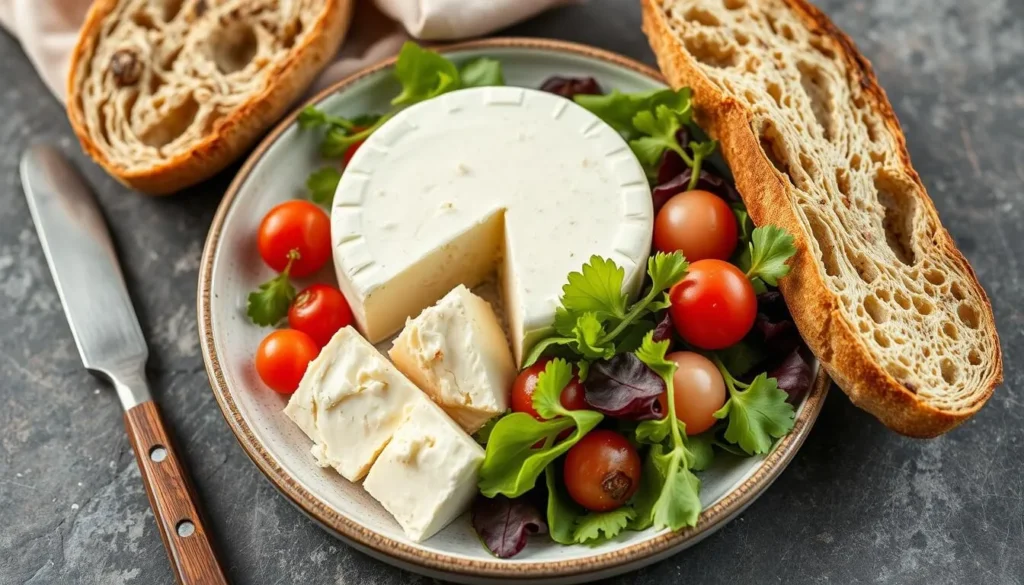
Rocamadour’s culinary delight is undoubtedly its goat cheese, produced using traditional methods for centuries. The town is famous for its AOC awarded goats cheese, a local delicacy that has been a staple in the region.
Hidden Gems Around Rocamadour
While strolling around the village and exploring the sanctuary are undoubtedly the main attractions, there are other hidden gems to discover around Rocamadour if you have a lot of time on your hands.
One of the must-try experiences is sampling the famous Rocamadour AOC goat cheese at its freshest, often served on salads or as part of a cheese plate. You can visit local producers or restaurants to learn about the cheese-making process and how this small, round cheese earned its prestigious Appellation d’Origine Contrôlée (AOC) status.
Some of the hidden gems around Rocamadour include the Grottes des Merveilles (Caves of Wonder), where you can marvel at impressive stalactites and stalagmites. You can also explore the Chapelle de l’Hospitalet, a small 13th-century chapel surrounded by a quiet cemetery and old ruins, which served as the final stop for pilgrims before reaching the sanctuary.
For a completely different experience, consider visiting La Forêt des Singes (Monkey Forest), where over 150 Barbary macaques roam freely in a natural environment, just minutes from the medieval village. This is a great place to visit with family, offering an exciting and educational experience.
When you visit Rocamadour, take your time to explore these attractions and enjoy the beauty of this medieval town. Whether you’re interested in history, nature, or simply relaxing in a beautiful place, Rocamadour has something to offer.
Chapelle de l’Hospitalet
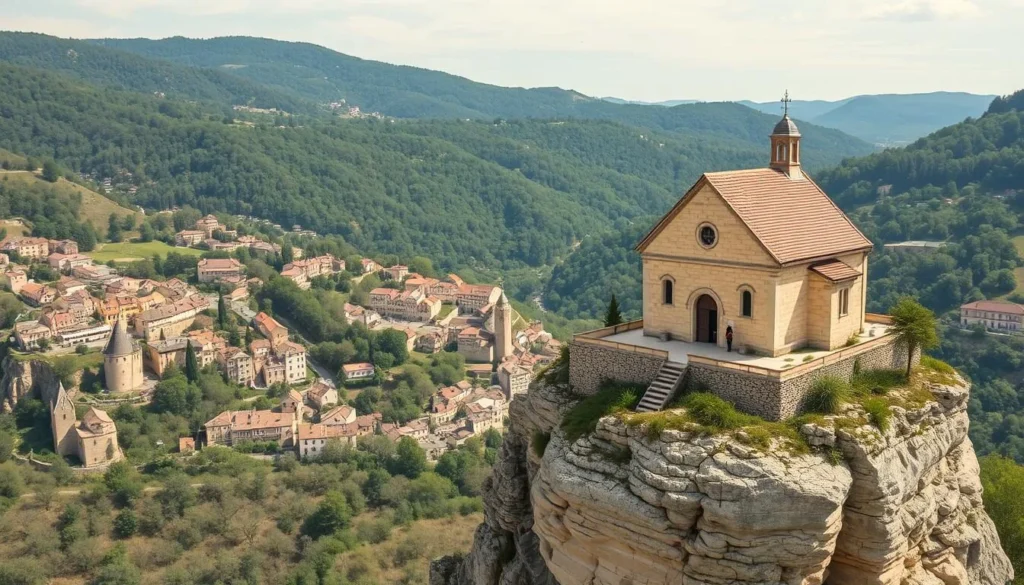
Perched on the cliff opposite the medieval village of Rocamadour lies the historic community of Hospitalet, home to the 13th-century Chapelle de l’Hospitalet. This tiny chapel is a significant site that served as the final resting point for pilgrims before they reached the Notre Dame Sanctuary. As you visit this charming chapel, you’ll be struck by its serene atmosphere and the surrounding quiet cemetery and old ruins.
The Chapelle de l’Hospitalet is not just a historical landmark; it’s a place where you can reflect on the spiritual journey of the pilgrims who once stopped here. You can wander through the ancient ruins, explore the cemetery, and step inside the tiny chapel to experience its tranquility. There’s even paid street parking right next to the chapel, making it easily accessible.
Grottes des Merveilles
Just a short distance from the Chapelle de l’Hospitalet, you’ll find the Grottes des Merveilles, or Caves of Wonder. This impressive natural site is a must-visit attraction, featuring stunning stalactites and stalagmites that have formed over thousands of years. As you explore the caves, you’ll gain a deeper understanding of the region’s geological history, characterized by its limestone terrain and numerous cave systems.
Exploring the Grottes des Merveilles is a bit like stepping into a natural cathedral, with the formations creating an otherworldly atmosphere. It’s a unique experience that complements a visit to the castle and the main sanctuary complex in Rocamadour. While it’s a bit off the beaten path, the tranquility and natural beauty make it well worth the trip.
As you explore these less-visited sites, you’ll discover that they offer a more tranquil experience, away from the crowds that often gather around the main attractions in Rocamadour. Yet, they still provide fascinating historical and natural attractions that enrich your understanding of this medieval village and its surroundings.
Day Trips from Rocamadour
If you’re staying in Rocamadour, there are plenty of fascinating places to discover on a day trip. The surrounding region is rich in history, natural beauty, and unique attractions that are easily accessible by car or other means.
Gouffre de Padirac: A Marvel of Nature
One of the most remarkable day trip destinations from Rocamadour is the Gouffre de Padirac, a massive chasm that leads to an extensive underground cave system. This natural wonder is a short drive from Rocamadour and is considered one of the coolest places to visit in the area.
The Gouffre de Padirac is recorded as the largest known chasm in the world, measuring 77 meters deep and 33 meters long. It continues into an intricate network of caves, featuring its own river that you can explore on a guided boat tour.
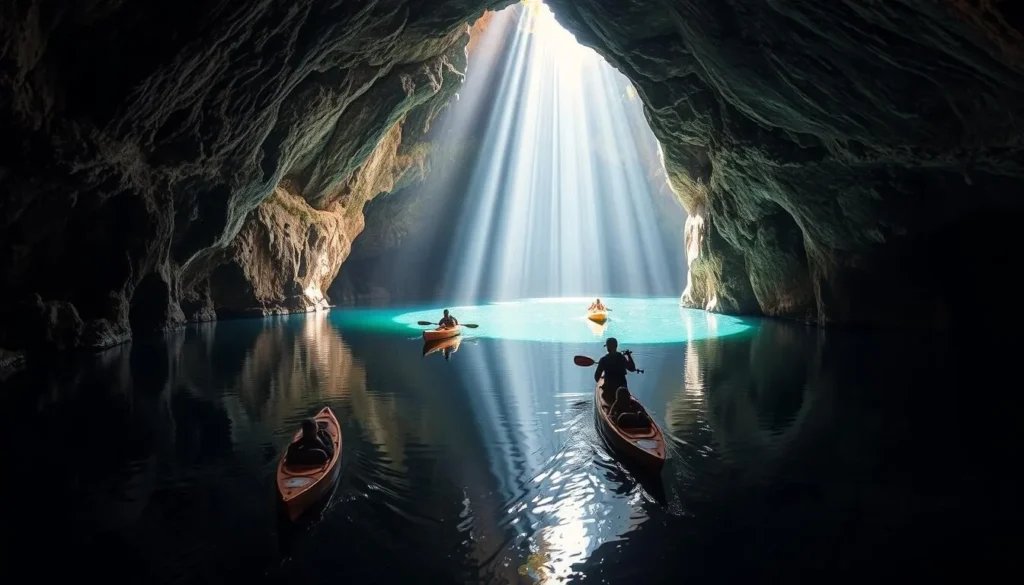
The highlight of your visit to Gouffre de Padirac is undoubtedly the underground river cruise. As you glide through the illuminated chambers, your captain-cum-guide shares insights into the geological formations and the history of the caves. It’s a magical experience that leaves a lasting impression.
Practical Tips for Visiting Gouffre de Padirac:
- Book your tickets in advance, especially during the peak summer months (July & August) when tickets sell out quickly.
- Bring a jacket or sweater as the temperature inside the caves is significantly cooler than outside.
- Be prepared for a visit duration of about 1.5 hours and an entrance fee of approximately €19.50.
- Note that photography and videography are not allowed during the boat tour, purportedly for safety reasons, though it may also encourage the purchase of souvenir photos.
Understanding the geological processes that have shaped Gouffre de Padirac over millions of years adds another layer of appreciation for this natural wonder. The region’s unique geology has created a breathtaking underground world that attracts visitors from around the globe, making it one of the most popular attractions in the Lot region.
As you plan your day trip to Gouffre de Padirac, consider exploring other nearby castles and medieval villages. The area is dotted with historical sites and picturesque towns, offering a rich tapestry of experiences that complement your visit to this remarkable chasm and its underground river.
Saint-Cirq-Lapopie Medieval Village
Perched 100 meters above the Lot River, Saint-Cirq-Lapopie is a tiny medieval hamlet that has captured the hearts of many visitors. This village, located in the Causses de Quercy Regional Nature Park, was originally built as a stronghold and now serves as a picturesque open-air museum.
With only about 10 permanent residents, Saint-Cirq-Lapopie is more of a historical attraction than a thriving village. However, its charm and historical significance make it a must-visit destination for anyone interested in medieval history. As you wander through its narrow streets, you’ll feel as though you’ve stepped back in time.
Castles of the Dordogne Valley
The Dordogne Valley, where Rocamadour is located, is renowned for its numerous snapshot-worthy castles, each with its own unique history and architecture. The region is rumored to have over 1,000 châteaux, many of which date back to the Hundred Years’ War between France and England.
- Visit Beynac Castle, dramatically positioned on a limestone cliff overlooking the Dordogne River.
- Explore Hautefort Castle, known for its classical French architecture.
- Discover Puyguilhem Castle, a fine example of Renaissance-style architecture.
These castles not only reflect the rich history of the region but also highlight the strategic importance of the Dordogne Valley during the medieval period. A visit to these sites provides a deeper understanding of the territorial disputes between France and England.
Planning day trips from Rocamadour to these nearby attractions is straightforward, as they are all within a two-hour drive radius. This makes Rocamadour an excellent base for exploring the broader region, including the beautiful village of Saint-Cirq-Lapopie.
Where to Stay in Rocamadour
To fully immerse yourself in Rocamadour’s charm, consider staying within the medieval village or its surroundings. The village and nearby areas offer a variety of accommodations to suit different preferences and needs.
Accommodations within the Medieval Village
Staying within the medieval village walls provides a unique and atmospheric experience. Hôtel du Lion d’Or is a recommended option, offering a central location and on-site parking. For a more luxurious stay, Hotel Beau Site is another excellent choice, known for its impeccable service and prime location.
When choosing to stay within the village, be aware that it can be busier during the day. However, the convenience of being able to walk to most attractions makes it an attractive option for many visitors.
Benefits of Staying in the Village
- Immerse yourself in the medieval atmosphere
- Easy access to main attractions
- Variety of dining options within walking distance
Accommodations outside the Medieval Village
For those preferring a quieter stay or more spacious accommodations, the nearby area of L’Hospitalet offers excellent alternatives. Logis Hôtel Le Belvédère is highly recommended for its stunning views of Rocamadour, ample on-site parking, and good value for money.
Another option is Hôtel Les Esclargies, a peaceful B&B that offers bicycle rentals, making it an ideal choice for those looking for a sustainable and serene stay just outside the village.

| Hotel Name | Location | On-site Parking | Notable Features |
|---|---|---|---|
| Hôtel du Lion d’Or | Within medieval village | Yes | Central location, 2-star hotel |
| Logis Hôtel Le Belvédère | L’Hospitalet | Yes | Stunning views, good value |
| Hotel Beau Site | Within medieval village | – | Prime location, excellent service |
| Hôtel Les Esclargies | Just outside the village | Yes | Peaceful B&B, bicycle rentals |
Ultimately, the choice between staying within the medieval village or in the surrounding areas depends on your personal preferences regarding atmosphere, convenience, and amenities.
Staying in L’Hospitalet for the Views
When planning your stay in Rocamadour, consider the charming hamlet of L’Hospitalet for its breathtaking views. Located on the cliff opposite Rocamadour, L’Hospitalet offers a unique vantage point to appreciate the medieval village’s beauty.
L’Hospitalet is not just about the views; it also provides several practical benefits. For one, parking is significantly easier compared to staying within Rocamadour itself. Moreover, accommodations in L’Hospitalet often offer better value for money, making it an attractive option for travelers looking to balance their budget with a memorable experience.
Best Value Options Near Rocamadour
One of the standout accommodations in L’Hospitalet is Hotel Bellevue. This hotel is renowned for its spectacular sunrise and sunset views over Rocamadour. Visitors can enjoy these views from the hotel’s parking area, where two stone benches offer an undisturbed view over the Alzou Valley and Rocamadour in the distance.
- Discover the advantages of staying in L’Hospitalet, including its unparalleled views of Rocamadour.
- Learn about accommodations like Hotel Bellevue that provide front-row seats to spectacular views.
- Understand the practical benefits, such as easier parking and better value for money.
- Find out about the Sacred Way, the road connecting L’Hospitalet to Rocamadour, which offers some of the best views.
The Sacred Way is a 12-minute walk or a short drive that connects L’Hospitalet to Rocamadour. While there isn’t a dedicated footpath, making it a bit tricky to walk, the route offers some of the most stunning views of the medieval village. Timing your visit to coincide with the golden hour can make for some incredible photography opportunities.
In conclusion, staying in L’Hospitalet offers a lot in terms of location and view. While it may be a bit removed from the main attractions in Rocamadour, the benefits of panoramic views and a quieter atmosphere make it well worth considering for your stay.
Practical Information for Visiting Rocamadour
If you’re planning to visit Rocamadour, understanding the peak tourist seasons can help you plan a more relaxed trip. The village, known for its medieval architecture and spiritual significance, attracts a large number of visitors, especially during certain times of the year.
Optimal Time to Visit
Between mid-April and mid-October, Rocamadour tourism peaks, with a staggering two million visitors. This can make the village feel overcrowded, as it’s relatively small. To avoid the crowds, consider visiting during the shoulder season, which includes March, April, May, October, or November.
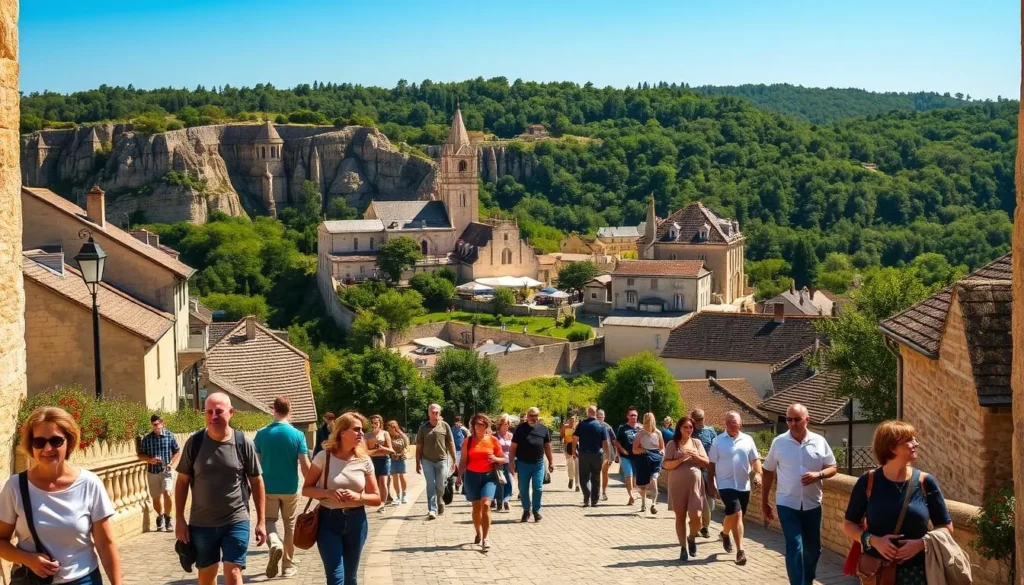
Visiting in mid-October, for instance, can provide a more serene experience. The average temperature is around 22°C (77°F), making it comfortable for exploring the village, visiting the Sanctuary, and hiking up to the castle without the peak season crowds.
Benefits of Visiting During the Shoulder Season:
- No long queues for attractions
- Peaceful hikes and exploration
- Choice of restaurants without needing reservations
- A more authentic experience of the village
For those who must visit during the peak season, planning your day strategically can help. Arriving early in the morning or visiting in the evening can make a significant difference, as day-trippers typically arrive mid-morning and leave by late afternoon.
How to Get to Rocamadour
To ensure a smooth start to your Rocamadour adventure, it’s essential to understand the parking facilities available. Rocamadour is a popular destination, and knowing where to park can save you time and reduce stress.
Parking Options
Rocamadour offers five official parking lots, each with different accessibility and proximity to the main attractions. Understanding these options can help you plan your visit more effectively.
| Parking Lot | Accessibility | Walk to Village | Notable Features |
|---|---|---|---|
| P1: Parking de l’Hospitalet | Motorhomes, vans, cars, buses | 10 minutes | Near L’Hospitalet |
| P2: Parking des Ascenseurs | Motorhomes, vans, cars, buses | Very close to Rocamadour Castle | Close to the lift entrance/exit |
| P3: Parking des Garennes | Cars | 10 minutes | Close to Forêt des Singes |
| P4: Parking du Garroustié | Vans, cars, small motorhomes | 25 minutes | Close to Forêt des Singes |
| P5: Parking La Vallee | Low and short vehicles | 10 minutes (uphill) | Not suitable for motorhomes or buses |
It’s important to note that all parking lots require payment at parking meters, with a daily fee of approximately €6. Planning your parking strategy based on your itinerary, vehicle type, and mobility needs can make a significant difference in your visit.
For instance, if you’re planning to visit Rocamadour Castle first, P2: Parking des Ascenseurs might be the most convenient option. On the other hand, if you’re looking for a more leisurely stroll into the village, P1: Parking de l’Hospitalet or P3: Parking des Garennes could be a better choice.
Using the Elevators for Easy Access
Rocamadour’s medieval village is now more accessible than ever, thanks to its innovative elevator system. This system allows visitors to easily navigate the village and its surroundings without having to worry about the strenuous steep alleys and innumerable steps typically associated with medieval hilltop villages.
The elevator system in Rocamadour is a game-changer for visitors of all mobility levels. With two sets of elevators, you can easily get from the center of the village (Rue Roland le Preux) all the way to Rocamadour Castle without having to take any stairs. The first elevator takes you from the village to the sanctuary level, while the second elevator continues from the sanctuary to the front of Rocamadour Castle.
![]()
Benefits for Families and Visitors with Mobility Issues
The elevator system in Rocamadour offers numerous benefits for families and visitors with mobility issues. Here are some key advantages:
- Easy access to the sanctuary and castle without having to navigate steep stairs
- Convenient ticket purchasing at the ticket booth on Rue Roland le Preux
- Affordable prices, ranging from €3.20 (sanctuary only) to €6.20 (all the way to the castle)
- Flexible operating hours: 9:00 AM to 7:00 PM in summer and 9:00 AM to 6:00 PM in winter
By utilizing Rocamadour’s unique elevator system, you can experience the beauty and history of this medieval cliff village without the physical challenge typically associated with such sites. Consider using the elevators as part of your strategy when visiting with family members who might have difficulty with the 216 steps of the Grand Staircase.
La Forêt des Singes (Monkey Forest)
La Forêt des Singes, or Monkey Forest, is a must-visit attraction near Rocamadour that offers anunforgettable experiencefor visitors of all ages. Located in a natural environment, this unique forest is home to over 150 Barbary macaques that roam freely, providing a captivating experience for all who visit.
As you explore La Forêt des Singes, you’ll have the opportunity to observe and interact with the monkeys in a setting that prioritizes animal welfare. This conservation-focused park is not only entertaining but also educational, offering insights into the behavior and habitat of these fascinating creatures.
Kid-Friendly Attractions and Activities
Rocamadour is not just a destination for history buffs and those seeking spiritual experiences; it’s also an excellent choice for families. In addition to La Forêt des Singes, you can visit the Grottes des Merveilles (Caves of Wonder), where children can marvel at the fascinating stalactites and stalagmites in an accessible cave system.
When planning your visit, consider timing it to coincide with seasonal events like the Hot Air Balloon Festival, held on the last weekend of September. Such events offer additional entertainment for families, making your trip to Rocamadour even more memorable.
While Rocamadour has a spiritual and historical focus, there are plenty of activities to keep children engaged and entertained throughout your visit. From exploring the medieval village to enjoying the natural beauty surrounding it, Rocamadour offers a diverse range of experiences that cater to all interests and ages.
- Visit La Forêt des Singes, a unique attraction where over 150 Barbary macaques roam freely.
- Explore the Grottes des Merveilles, featuring fascinating stalactites and stalagmites.
- Enjoy seasonal events like the Hot Air Balloon Festival for additional family entertainment.
By incorporating these activities into your itinerary, you’ll ensure a well-rounded and enjoyable experience for your family in Rocamadour.
Dining in Rocamadour: Where to Eat
Dining in Rocamadour is an experience in itself, with traditional restaurants and casual cafés offering breathtaking views. As you explore this medieval village, you’ll find a range of dining options to suit every taste and preference.
Traditional Restaurants in the Village
Rocamadour is known for its local Quercy cuisine, which features specialties such as Rocamadour goat cheese, duck confit, black truffles, and walnuts. When dining in the village, you can expect to find restaurants serving these regional delicacies.
Some top recommendations for dining in Rocamadour include Hôtel Beau Site, which offers a pleasant terrace with a few vegetarian-friendly options, and La Maison de Famille, which serves a variety of pancakes, galettes, and salads with plenty of vegetarian choices.
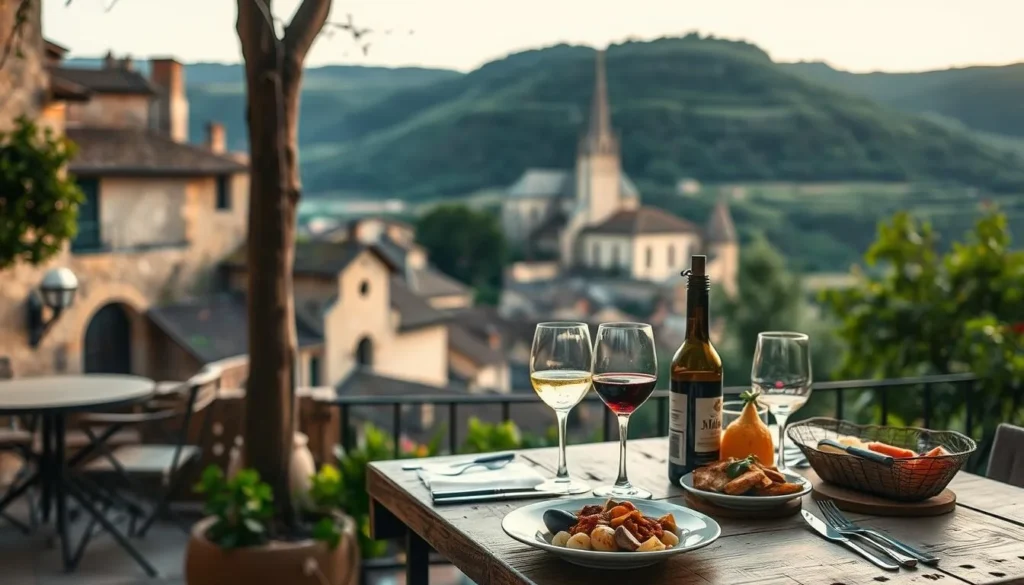
| Restaurant | Cuisine | Price Range |
|---|---|---|
| Hôtel Beau Site | Traditional Quercy | Moderate |
| La Maison de Famille | French, Vegetarian | Budget-Friendly |
When planning your visit to Rocamadour, keep in mind that making lunch reservations during peak season is advisable, as the town can get crowded. Dinner tends to be less crowded, making it a great time to enjoy a more relaxed meal.
It’s worth noting that most restaurants in the village cater to tourists, so prices may be higher than in less-visited towns in the region. However, the unique dining experience and stunning views make it well worth the visit.
Cafés with the Best Views
Rocamadour’s breathtaking landscapes are best appreciated from one of its many charming cafés. As you sip your coffee or enjoy a glass of local wine, you can take in the panoramic vistas that make this village so special.
One of the top recommendations is the Belvedere Restaurant in L’Hospitalet. Its terrace offers one of the best views looking directly across at Rocamadour clinging to the cliff face. It’s the perfect spot to relax and enjoy the scenery.
The Changing Seasons in Rocamadour
Rocamadour changes dramatically through the seasons. From the bustling energy of summer to the tranquil beauty of autumn and spring, each season offers a unique experience. In the spring, the wildflowers are in bloom, adding vibrant colors to the landscape. Summer brings festivals and events, while autumn is characterized by its warm, golden hues. Winter, on the other hand, offers a serene and peaceful atmosphere, with the possibility of having viewpoints entirely to yourself.
Understanding the seasonal rhythm of Rocamadour is key to planning your visit. The village is crowded with over two million visitors between mid-April and mid-October. If you’re looking for a more peaceful experience, consider visiting during the shoulder seasons – March, April, May, October, or November. We visited in mid-October and found that the village was practically deserted, with comfortable temperatures around 22°C (77°F).
Visiting in October has its advantages. The crowds have significantly diminished, but the temperatures remain pleasant. You can enjoy the hike up to the castle without the queues, and you have your pick of restaurants to dine in. It’s a great time to experience Rocamadour like a local.
As you plan your visit, keep in mind the different experiences each season offers. Whether you’re looking for a vibrant atmosphere or a peaceful retreat, Rocamadour has something to offer. Take your time to enjoy the views, and make the most of your experience in this beautiful village.
Summer Festivals and Events
Visiting Rocamadour can be a vastly different experience depending on thetimeof year, with summer bringing festivals and crowds, while off-season offers serenity. During the peak tourist season, the village is alive with various cultural events and festivals that attractvisitorsfrom all over.
A Season of Festivals
Summer is a greattimeto experience the vibrant atmosphere of Rocamadour, with numerous festivals taking place. One of the highlights is the annual Rocamadour Hot Air Balloon Festival, held on the last weekend of September. This event is a must-see, with dozens of colorful balloons filling the sky above the village.
You can also experience the rich history and culture of Rocamadour during the summer months through its various cultural events. However, it’s worth noting that this period attracts a large number of people, making the village quite crowded.
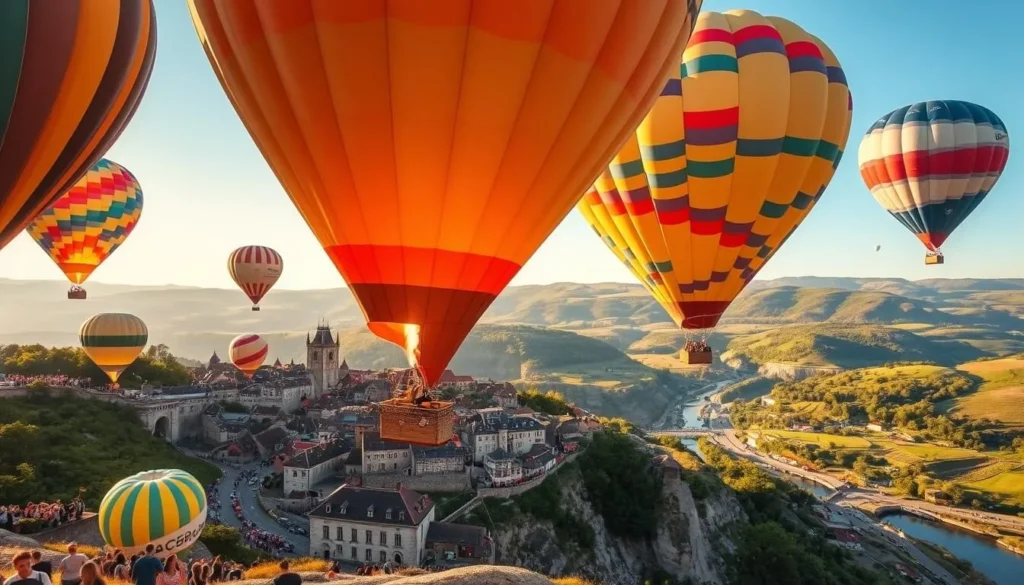
In contrast, visiting during the off-season (March-May or October-November) allows you to enjoy Rocamadour without the crowds, providing a more authentic experience. You can explore the medieval village at your own pace, visit the Sanctuary without queues, and enjoy the peaceful surroundings.
During your visit, you can appreciate the practical benefits of traveling during the shoulder season, such as easier parking and the ability to take unobstructed photos of the village’s iconic views. With fewer visitors and people around, you can have a more relaxed and enjoyable time exploring Rocamadour.
Creating the Perfect Rocamadour Itinerary
Making the most of your day in Rocamadour involves exploring its medieval architecture, religious sanctuaries, and panoramic viewpoints. With a well-planned itinerary, you can experience the highlights of this ancient village efficiently.
One-Day Itinerary: The Highlights
To make the most of your visit to Rocamadour, consider the following one-day itinerary:
- Start your day early at one of the viewpoints in L’Hospitalet to capture the morning light on the village before heading to the main entrance at Porte du Figuier.
- Stroll along the main street (Rue Roland le Preux) to appreciate the medieval architecture before climbing the Grand Staircase to the sanctuary complex.
- Explore the Notre Dame Chapel with its Black Madonna, the Basilique Saint-Sauveur, and the other religious buildings that make up the sanctuary.
- Continue up the Chemin de la Croix (Way of the Cross) to Rocamadour Castle for panoramic views from the ramparts.
- End your day with a visit to a local restaurant to sample Rocamadour cheese and regional specialties, perhaps with a view of the illuminated village if you’re staying overnight.
While Rocamadour is a small village that can be visited in a few hours, spending at least one full day and one night allows you to fully immerse yourself in its beauty and history. You’ll have the added benefit of enjoying the village before 9:00 AM and after 6:00 PM when the tour groups have left, making your experience even more special.
By following this itinerary, you’ll be able to make the most of your time in Rocamadour and create lasting memories of your visit to this incredible destination.
Two-Day Itinerary: Immersive Experience
To truly experience the essence of Rocamadour, allocate at least two days to discover its hidden gems. This medieval village, perched on a cliff, offers a unique blend of history, spirituality, and natural beauty.
A two-day itinerary allows you to explore Rocamadour at a relaxed pace. On your first day, focus on the medieval village, the sanctuary complex, and the castle. Take your time to enjoy the viewpoints at different times of the day, capturing the changing light and atmosphere.
Dedicate your second day to exploring the surrounding attractions. Visit the Gouffre de Padirac underground river, the charming village of Saint-Cirq-Lapopie, or some of the Dordogne Valley castles. Each of these destinations offers a unique experience that complements the Rocamadour visit.
One of the benefits of staying overnight in Rocamadour is having the village to yourself before 9:00 AM and after 6:00 PM, when the day tourists have left. This allows for a more authentic experience of this ancient pilgrimage site. You can enjoy the magical atmosphere, explore the many little chapels and churches in the Sanctuary, and hike up to the Rocamadour Castle without the crowds.
Rocamadour’s timeless appeal lies in its perfect harmony between natural landscape and human ingenuity. As an old local saying describes it, “Houses on the river, churches on the houses, rocks on the churches, castle on the rock” – a testament to the unique character of this place. Whether you’re visiting for a day or staying for two, Rocamadour is a destination that will captivate you, just as it has pilgrims for centuries.
In conclusion, a visit to Rocamadour is a day to remember, with its rich history, spiritual significance, and breathtaking landscapes. Take your time to soak in the atmosphere, and you’ll find that this medieval village has a lasting impact on your travel experiences.
The above is subject to change.
Check back often to TRAVEL.COM for the latest travel tips and deals.
